

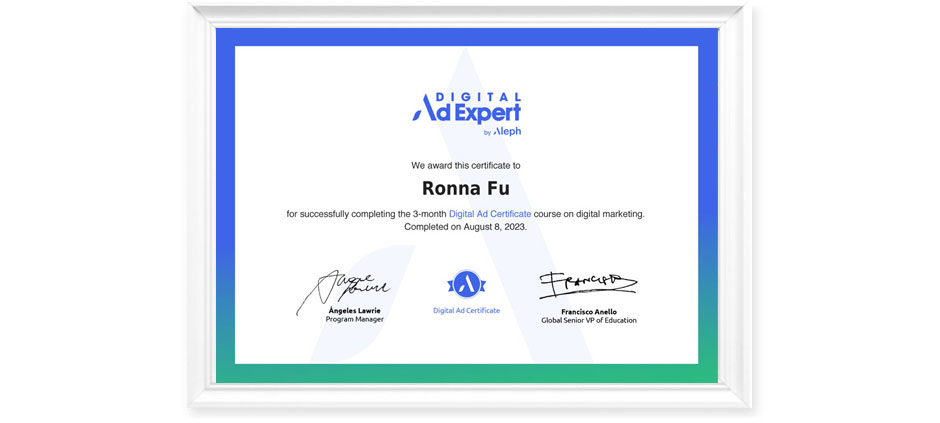
Digital Ad Expert in Digital Marketing is a three months part-time course by Aleph. Digital Marketing is a step-by-step approach to marketing strategy, giving the student the tools to create a precise and successful online marketing campaign. Live classes were held twice a week, and each class lasted 2 hours.
I gained knowledge about every aspect of digital marketing, from its fundamentals to its formal terms, applications, and techniques. The course includes all current data on digital realities to aid in the development of an awareness of the significance of social media in the modern world. I gained knowledge about how this material is consumed and how it affects society, people, brands, and businesses.
The programme covered how to implement a marketing plan with a specific goal. A major goal is to comprehend the range of available marketing objectives. In order to achieve this, we learned to thoroughly understand the company we want to promote in order to decide on the right audience to communicate with and the most effective method.
I have just completed the first SEO (Search Engine Optimisation) training with HubSpot. Moving on to the next step, ie, SEO II. I have been studying more than usual to keep up with social media marketing, SEO and any topics related to equip me serving my customers better.
Below is my certificate of achievement from HubSpot. HubSpot is a digital marketing industry leader, and their blogs, videos, and certification courses are very popular. The cloud-based CRM HubSpot was created to aid in the alignment of sales and marketing teams, promote sales enablement, increase ROI, and optimise inbound marketing strategy to produce more qualified leads.
I would be pleased to manage your website and make any suggestions for adjustments that can enhance user experience. Please feel free to drop Ronna an email and include a brief message describing what you need done.
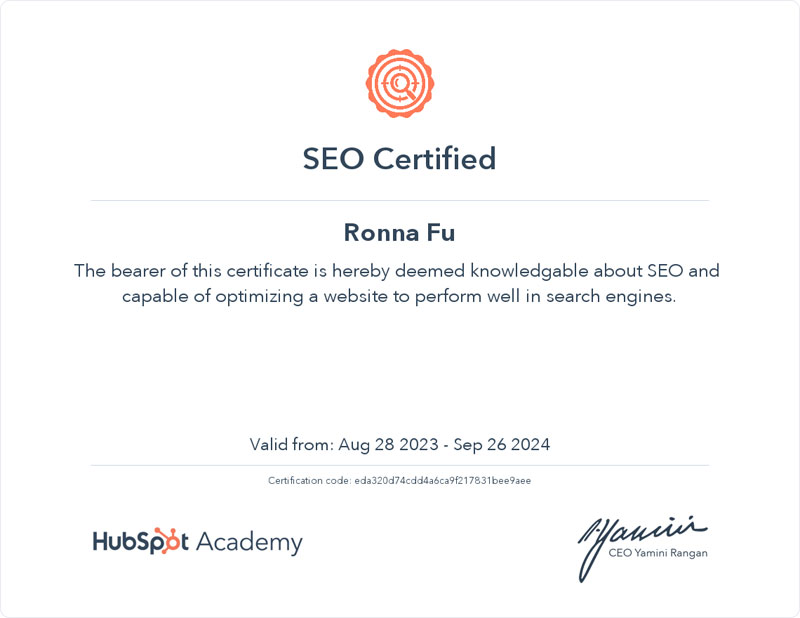
I previously completed a course called SEO Strategies through Great Learning. Great Learning provides online traning on topics like AI, ML, data science, digital marketing, cloud, software engg & more.
The course covers the following topics:
> Introduction to Digital Marketing?
> Why Digital Marketing?
> SEO and working with SEO
> Keyword and SERP Analysis
> Original and Quality Content
> Understanding Local SEO, Optimisation
> Understanding Customer and Performance Matrix
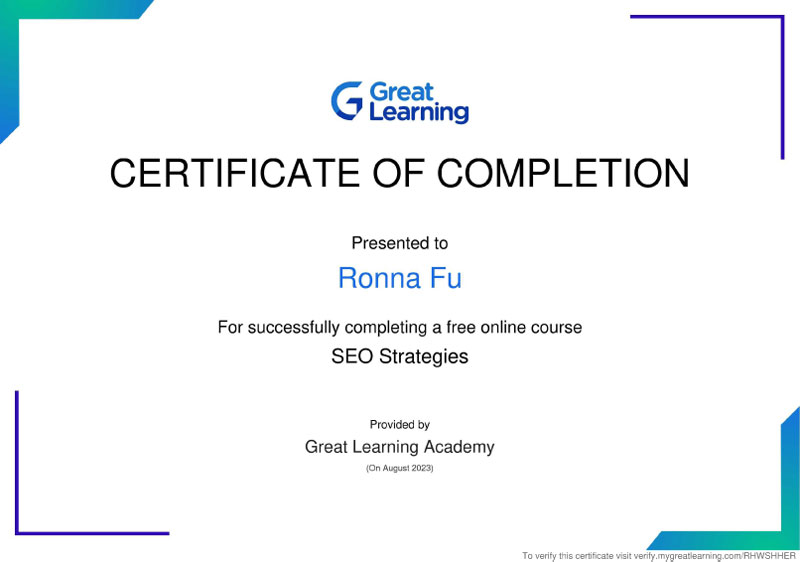
The acronym CSS stands for “Cascading Style Sheets.” In web design and development, it is a style sheet language used to regulate the visual presentation and layout of HTML content. CSS is used to specify how elements of a web page should appear and be placed on screens or other media devices.
The CSS term “cascading” describes how styles are applied in a hierarchy. Styles can be specified at many levels, such as directly within HTML elements, using style tags in the document’s <head>, or in distinct external CSS files.
The way CSS functions is by offering a set of rules that specify distinct stylistic characteristics for specific HTML components. These characteristics range from borders and spacing to colours, typefaces, and more. Web designers and developers can construct consistent and aesthetically pleasing websites while retaining a clear structure by separating the content (HTML) from its presentation (CSS).
Some key concepts of CSS are as follow:
Selectors are patterns that are used to focus on particular HTML components. The items to which the CSS rules will be applied are chosen via selectors.
Values provide the precise style elements that will be altered, such as “colour” or “font-size.” Values are the settings that have been applied to those properties, like “blue” or “16px.”
CSS classes and IDs are used to categorise items and apply particular styling to them. While IDs are intended to serve as specific identifiers for particular items, classes are reusable and can be used to multiple elements.
The box model specifies the content, padding, border, and margin of elements as well as how they are shown. Controlling spacing and layout is essential.
CSS is used to develop responsive web designs, which change to fit various screen sizes and devices. A CSS feature called media queries enables styles to be applied based on the features of the screen.
External style sheets are independent CSS files that can be created and then linked to HTML documents. It is simpler to maintain and update.
CSS attributes have the ability to inherit values from parent elements, enabling uniform styling between nested items.
You can apply styles to particular states of elements (like hovering over a link) or build virtual elements (like putting information before or after an element) using pseudo-classes and pseudo-elements.
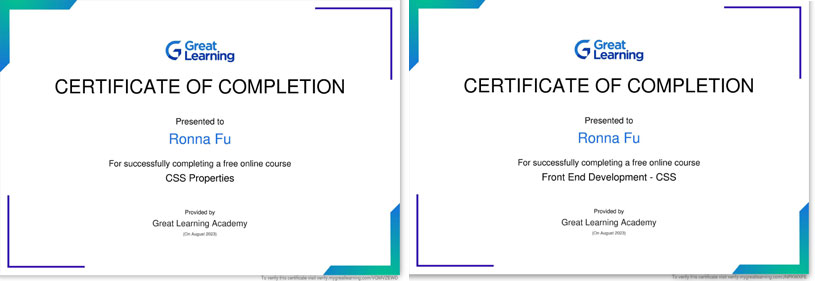
My interest in the subject led me to educational providers like Greater Learning and HubSpot. To stay up to date on the latest in web design, I am continuously researching, learning, and educating myself.
A Google Search campaign is a particular type of online marketing campaign that runs through Google Ads, formerly known as Google AdWords, Google’s platform for online marketing. When consumers conduct a Google search for a certain keyword, text advertising are intended to be displayed to them.
Google Search campaigns are an effective approach to reach people who are looking for items or services similar to yours right now. They enable you to connect with a very targeted audience and track the success of your campaign using statistics like clicks, impressions, click-through rate (CTR), and conversion rate.
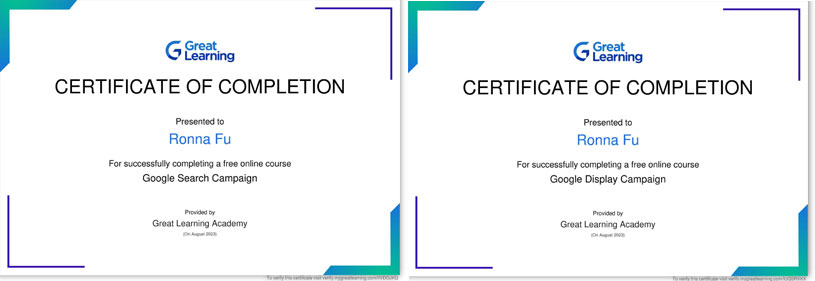
Choosing keywords that are pertinent to your enterprise, goods, or services is the first step in conducting keyword research. These are the terms and phrases that customers might type into the Google search box to find products and services similar to yours.
You produce text-based advertisements that are pertinent to the selected keywords. Every advertisement normally has a headline, a few lines of information, and a display URL.
The maximum bid that you set for each term is what you’re willing to spend when someone clicks on your ad. The position of your ad on the search results page is determined by this bid together with other elements like ad relevancy and quality score.
Google’s Ad Rank algorithm determines the position of the adverts on the search results page. Your bid, ad quality, anticipated click-through rate, ad relevancy, landing page experience, and other variables are used to determine your ad rank.
Google’s algorithm chooses which advertisements to display when consumers search for a keyword you’re targeting depending on the Ad Rank. Depending on the competition and your bid, your ad may appear at the top, bottom, or side of the search results page.
The cost-per-click (CPC) bidding mechanism determines how much you are charged if a user clicks on your advertisement. The most you’re willing to spend on the campaign is your budget.
A user is taken to a landing page on your website when they click on your advertisement. The landing page should give a positive visitor experience and be pertinent to the advertisement.
You keep an eye on the campaign’s effectiveness using the reporting tools provided by Google Ads. To increase the effectiveness of the campaign, you can change bids, add new keywords, halt underperforming advertisements, and execute other optimisations.
ChatGPT is a language model developed by Open AI. It creates text that appears human. It belongs to the larger family of GPT (Generative Pre-trained Transformer) models. ChatGPT can answer queries, produce text, give explanations, and conduct other natural language processing tasks because it has been trained on a wide variety of internet text. It’s frequently employed in chatbot applications, virtual assistants, content creation, and other applications.
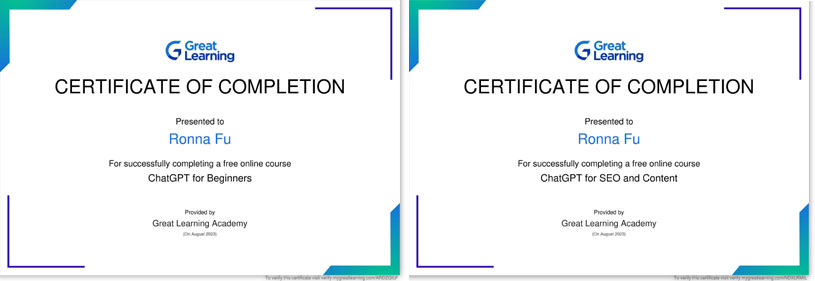
I recently finished two ChatGPT courses offered by Greater Learning. ChatGPT basics was the first course. I made the decision to continue learning ChatGPT for SEO and Content because I wanted to deepen my understanding of the topic.
It can be very successful to use ChatGPT for SEO (Search Engine Optimisation) and content generation. Here’s how to use ChatGPT for these objectives:
ChatGTP can help you with the creation of relevant and high-quality material for your website, blog, or social media platforms. You can use it to write articles, product descriptions, and more, as well as to brainstorm ideas. Simply give ChatGPT a topic or a brief, and it will generate material for you.
You can find suitable keywords for your content with the aid of ChatGPT. Describe your subject or sector, and ChatGPT will offer suggestions for keywords that will boost the SEO of your material. Long-tail keywords, which are more particular and have less competition, can also be requested.
You can use ChatGPT to get ideas for engaging article titles and persuading meta descriptions. These are essential for increasing click-through rates and attracting visitors’ attention in search engine results.
If you provide ChatGPT access to your current material, it can make recommendations on how to improve its search engine exposure. It can help you find areas in which you can organically add keywords, make your writing easier to read, and increase user engagement.
ChatGPT can offer suggestions for a content calendar and plan your content marketing objectives. Based on your target demographic and current market trends, it can recommend content subjects, formats, and distribution methods.
Use ChatGPT as a chatbot on your website to respond to frequent user questions. By doing this, you can improve user experience, lower bounce rates, and maintain visitors’ interest in your website.
If your company has a physical presence, ChatGPT can assist you in developing content for local SEO campaigns. It can produce localised content like directions, neighbourhood guides, and event notices.
Technical SEO terms like website structure, schema markup, and mobile optimisation can be explained with help from ChatGPT. You can use this to better comprehend search engine optimisation for your website.
Use ChatGPT to create FAQs and how-to manuals for your goods or services. This can increase the authority of your website and give visitors useful information.
*search engine landscape evolves over time, You need to stay up-to-date with the latest SEO best practices.

A Media Buyer is a specialist who plans and executes marketing initiatives. The Buyer is in charge of creating, putting into action, and optimising strategies in addition to planning and overseeing campaigns.
What a Media Buyer should do before launching a campaign or marketing plan is something that I cannot emphasise enough. A media buyer should first look at the client’s network profile, any prior performance, and the sales data on the company or business. The Buyer should also conduct market, competitive, and situational research. By doing an internal analysis of behaviours and results as well as an external examination of the competition using the information at hand, the Buyer can go forward with a wise proposal for action.
With the knowledge of creating and understanding the audience and buyer personas, the Buyer can now develop a strategy based on the data gathered, as well as the media planning and budget.
The Media Buyer must be familiar with the functionality of each platform or tool where the campaigns will be launched. The Buyer picks the right objective for each platform, segment the right audience, and use the right creatives.
The Buyer must be responsible for analysing the measurements or KPIs to determine their status and whether or not they are effective. Based on this research, the Buyer must make changes to optimise the campaign and improve outcomes.
In short, a Media Buyer should do research as their first step, defining the audience or buyer persona, defining a strategy, creating and executing social media campaigns, and last but not least, analysing, monitoring, and optimising campaigns.

AUDIENCE: The target market for a digital marketing campaign or strategy is referred to as the audience. It is critical to recognise and comprehend the demographic traits, interests, behaviours, and demands of this audience to effectively adapt messages and marketing methods.
TARGET: The target is the particular audience segment that a marketing effort seeks to engage. It is the most accurate and thorough depiction of the target audience’s psychographic and demographic traits. To develop pertinent messages and content that resonate with a given set of individuals, a suitable target must be defined.
KEY PERFORMANCE INDICATORS: Key performance indicators, or KPIs, are used to assess the efficacy of social media marketing campaigns and strategies. These metrics may include reach, engagement, follower count, website traffic, and conversions, among others. KPIs make it possible to assess the efficacy and impact of marketing initiatives and to make defensible choices that will maximise outcomes.
OBJECTIVES: The particular goal of a social media campaign or plan is referred to as the objective in digital marketing. Among other things, objectives may include stimulating audience participation, generating leads, raising revenue, and enhancing brand exposure. To direct operations and assess a strategy’s effectiveness, it is crucial to set clear, measurable objectives.
BUDGET: The budget is the amount of money set aside for the execution of a social media marketing campaign. Expenses for content generation, ad promotion, graphic asset development, and employing external services, among other things, may be included in the budget. It is critical to allocate and manage the budget efficiently in order to meet defined goals and maximise return on investment.